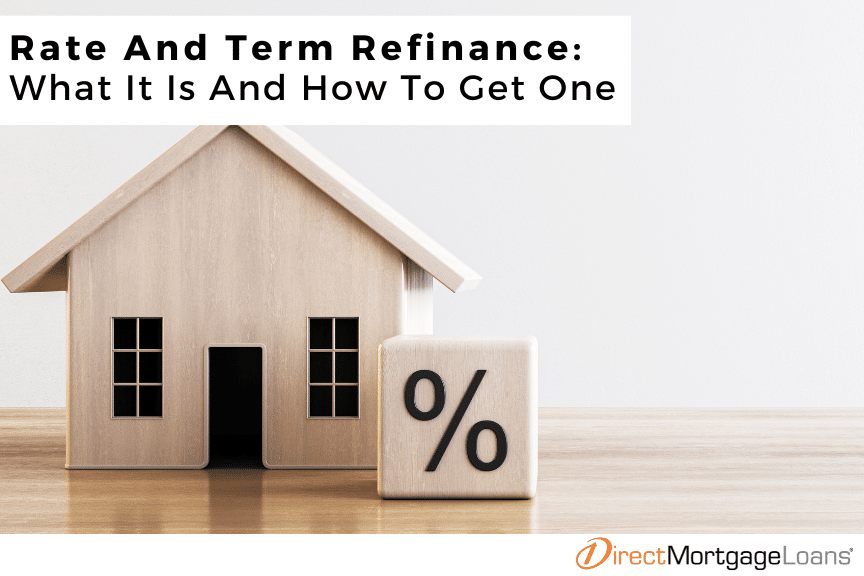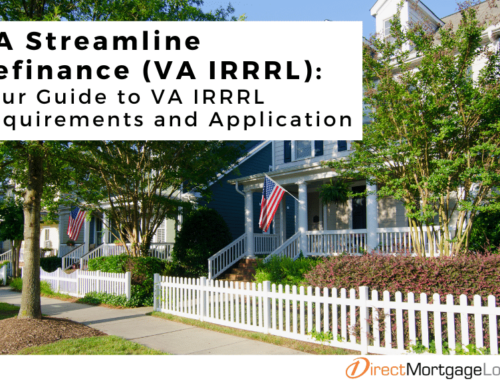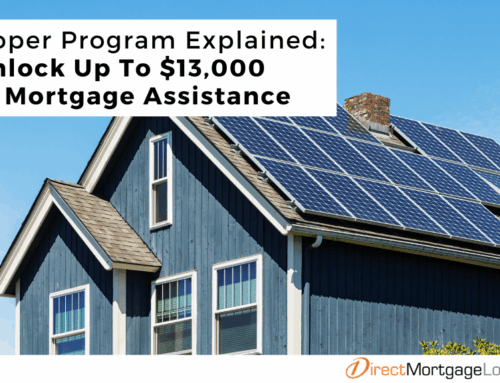Before diving into the specifics, it’s important to understand why many homeowners consider refinancing in the first place. Life changes, market shifts, and evolving financial goals could all lead to the need for a mortgage update. One common refinancing option is the rate and term refinance—a strategic method to improve your loan without taking on additional debt.*
Subscribe to our blog to receive notifications of posts that interest you!
What is a rate and term refinance?
A rate and term refinance is a mortgage refinance option allowing homeowners to replace their existing home loan with a new one that offers either a lower interest rate, a different loan term, or both. The key difference from other refinance types is that a rate and term refinance does not involve pulling cash out from your home’s equity. Instead, it focuses solely on improving the terms of your mortgage.
How does a rate and term refinance work?
During a rate and term refinance, your current mortgage is paid off using a new loan with updated terms. This could involve changing your loan from a 30-year term to a 15-year term or switching from an adjustable-rate mortgage (ARM) to a fixed-rate mortgage. The primary goal of a rate and term refinance is to reduce your monthly payment, pay off the mortgage faster, or gain more predictable payments over time.
The process typically involves several key steps to ensure a smooth refinance. First, you will need to check your eligibility by reviewing your credit score, home equity, and financial profile. Next, it’s important to shop around and compare loan offers from different lenders to find the most favorable terms. After selecting a lender, you will submit a formal application and provide supporting documentation like income verification and asset statements. Your lender will usually require a new home appraisal to confirm the current market value of your property. Once your application and appraisal are approved, you’ll move to the closing stage where you review the final loan terms, sign the necessary paperwork, and officially close on your new mortgage—much like the process you followed when you first purchased your home.
Rate and Term Refinance Example
Let’s say you currently have a 30-year mortgage for $300,000 at a 7% interest rate. Using a basic mortgage calculator, your monthly principal and interest payment would be about $1,996. Over the life of the loan, you’d pay roughly $418,527 in interest, bringing the total repayment amount to approximately $718,527.
Now let’s look at a 15-year refinance option at a 5% interest rate. Your monthly principal and interest payment would increase to about $2,372. However, over 15 years, you’d pay only around $127,003 in interest, for a total repayment of about $427,003.
Even though the monthly payment is higher by roughly $376, you would save approximately $291,524 in interest over the life of the loan. Plus, you’d pay off your home in half the time. This approach is especially beneficial for homeowners who can comfortably manage a slightly higher payment each month and want to maximize long-term savings and home equity.
Advantages of a Rate and Term Refinance
Choosing to pursue a rate and term refinance can open the door to several meaningful benefits for homeowners. Whether you’re looking to save money in the long term, achieve more predictable monthly payments, or accelerate your path to full homeownership, this refinancing option can be a smart move depending on your financial goals. Understanding the advantages could help you decide if a rate and term refinance aligns with your needs. Here are some of the benefits to choosing a rate and term refinance:
- Lowering the interest rate of your mortgage loan could significantly reduce both your monthly mortgage payment and the total interest you’ll pay over the life of the loan. Even a small drop in interest rate could lead to thousands of dollars in savings.*
- Changing the loan term could allow you to better align your mortgage with your financial goals. For example, moving from a 30-year term to a 15-year term could help you pay off your home sooner and build equity at a faster pace, although lowering your mortgage term typically increases your monthly payment.
- Switching from an adjustable-rate mortgage (ARM) to a fixed-rate mortgage could offer stability and predictability, especially in a rising interest rate environment. This change ensures your monthly payments remain consistent over time.
- If your home has increased in value and your equity has grown, then a rate and term refinance may also help you eliminate private mortgage insurance (PMI), further reducing your monthly costs.
Rate and Term Refinance Requirements
Qualifying for a rate and term refinance involves meeting certain financial and property-related standards set by lenders. Because refinancing adjusts the terms of your mortgage, lenders want to ensure you are in a strong position to manage the new loan. This evaluation looks at key areas like your credit profile, the amount of equity you have built in your home, and your ability to afford the new payments. Being well-prepared and understanding these requirements ahead of time can improve your chances of securing favorable refinancing terms.
To qualify for a rate and term refinance, lenders typically evaluate several key factors to determine your eligibility:
- A credit score of at least 620 is generally the minimum required, but borrowers with higher scores may be offered more favorable terms, including lower interest rates and reduced fees.
- Having at least 20% equity in your home is ideal, especially if you want to avoid private mortgage insurance (PMI). This means that the amount you owe on your mortgage should be no more than 80% of your home’s current appraised value.
- Your debt-to-income (DTI) ratio usually should be below 43%. This ratio compares your monthly debt obligations to your gross monthly income, and helps lenders assess your ability to repay the loan comfortably.
- You’ll need to provide documentation to support your financial profile, such as recent pay stubs, W-2 forms, tax returns, and bank statements. These documents help verify your income, employment history, and financial stability.
- A home appraisal is typically required to determine the current market value of your home. This ensures the loan amount aligns with the value of the property and confirms your equity level.
- Some lenders enforce a seasoning requirement, which refers to how long you must have owned your home or how long the original mortgage has been in place before refinancing. A common standard is at least 120 days of ownership, though this may vary by lender and loan program.
Cash Out Refinance vs Rate and Term Refinance
The main difference between a cash-out refinance and a rate and term refinance lies in how you utilize your home equity. With a cash-out refinance, you’re tapping into the equity you’ve built in your home by borrowing more than your current mortgage balance and taking the difference in cash. This lump sum can be used for a variety of purposes such as renovating your home, consolidating higher-interest debts, funding a major purchase, or covering educational expenses. However, because you’re increasing your loan amount, your monthly payments may rise, and you could end up paying more in interest over the life of the loan.
On the other hand, a rate and term refinance does not offer any cash back. Instead, a rate and term refinance is focused purely on restructuring the loan to improve your financial outlook—by lowering your interest rate, changing the length of your loan term, or both. It’s often used by borrowers who want to reduce their monthly mortgage payments, build equity faster, or gain stability by switching from an adjustable-rate to a fixed-rate mortgage. This option tends to be more conservative and cost-effective, especially for those not in need of extra funds.
Who Should Consider Rate and Term Refinance?
A rate and term refinance may be a great fit for a variety of homeowners who want to strengthen their financial future or better align their mortgage with their current goals. Here are some examples:
- Homeowners with higher interest rates who want to lock in a lower one. Refinancing to a lower rate can significantly reduce monthly payments and save thousands of dollars in interest over the life of the loan.
- Borrowers looking to shorten or lengthen their loan term to better fit their financial goals. Shortening the term, such as moving from a 30-year loan to a 15-year loan, can help you build equity faster and own your home outright sooner. Extending the term could reduce monthly payments and ease budget pressures.
- Those who want more stable payments by switching from an ARM to a fixed-rate mortgage. An adjustable-rate mortgage may initially offer lower payments. However, refinancing into a fixed-rate mortgage provides long-term predictability and protection against rising interest rates.
- Anyone who has improved their credit and now qualifies for better loan terms. A higher credit score can help you secure a more favorable interest rate and better overall loan conditions. This makes refinancing a strategic financial move.
How to get a rate and term refinance?
Getting a rate and term refinance involves a few strategic steps. These steps ensure you are setting yourself up for financial success. Taking time to prepare before starting the process can help you secure the best possible terms. Here are the steps to start your rate and term refinance:
- Review your current mortgage and financial goals. Take a close look at your current loan terms, interest rate, and monthly payment. Identify your refinancing goals, such as lowering your monthly payment, switching loan types, or paying off your home faster.
- Check your credit score and gather financial documents. Your credit score will influence the rates and terms you qualify for, so review your credit report for accuracy. Collect necessary documents like pay stubs, tax returns, bank statements, and your current mortgage information to streamline the application process.
- Talk to a loan officer at Direct Mortgage Loans. Working with an experienced loan officer can help you understand your options and select the best loan product for your needs. They will walk you through different scenarios and help you estimate your new monthly payment.
- Submit your application and authorize a home appraisal. Once you choose a lender and loan program, submit your completed application. Most lenders will require a new home appraisal to verify the current market value of your home. This also confirms sufficient equity.
- Review your final loan terms and close on your new mortgage. After your loan is approved, carefully review the final terms and closing disclosure. At closing, you’ll sign all necessary paperwork to complete your refinance and officially start benefiting from your new mortgage terms.
Working with a trusted lender like Direct Mortgage Loans can make the process smoother, more transparent, and ensure you’re getting loan terms that truly support your financial goals.
Rate and Term Refinance FAQ’s
What documents do I need for a rate and term refinance?
To complete a rate and term refinance, you’ll typically need to provide several financial documents to your lender. These include recent pay stubs to verify your income. W-2s or tax returns assess employment history and annual earnings. Bank statements show your assets and savings. You’ll also need your current mortgage statement and information on other debts, which help the lender evaluate your debt-to-income ratio. Having all of this documentation prepared can streamline the approval process. Working with Direct Mortgage Loans will offer you fast and convenient services like the DML App, where you can quickly communicate with your Loan Officer and upload important documents immediately and securely.
Will I need a new home appraisal for a rate and term refinance?
Yes, most lenders will require a new home appraisal to determine the current market value of your property. This ensures the home’s value supports the new loan amount. It also confirms the level of equity you have in the property. The appraisal may also impact whether you can eliminate private mortgage insurance (PMI) if your equity exceeds 20%. In some cases—such as with certain streamlined refinance programs—an appraisal might be waived, but this is less common.
Can you roll closing costs into a rate-and-term refinance?
Yes, many lenders give you the option to include closing costs in your new mortgage loan amount. You won’t need to pay thousands of dollars upfront at the closing table. This can be helpful if you’re trying to preserve savings. However, rolling the costs into your loan will slightly increase your loan balance and the amount of interest paid over time
Can you get cash back on a rate and term refinance?
No, a rate and term refinance does not provide cash back at closing. Its sole purpose is to revise the interest rate, the loan term, or both. This helps you save money in the long run or reach financial goals like faster repayment. If your objective is to tap into your home equity and receive funds directly, then you would need to explore a cash-out refinance instead. instead.
What is the waiting period for a rate and term refinance?
Lenders often require a seasoning period. This refers to the amount of time you must own your home before you’re eligible to refinance. This period is typically around 120 days but can vary depending on the lender or the specific refinance product. Some government-backed loan programs, such as FHA or VA, may have slightly different requirements. It’s advisable to speak with your loan officer to confirm the timing rules for your situation.
*Rates may vary. By refinancing your existing loan, total finance charges may be higher over the life of your loan.
Eligibility and approval is subject to completion of an application and verification of home ownership, occupancy, title, income, employment, credit, home value, collateral and underwriting requirements. Direct Mortgage Loans, LLC is licensed in Maryland. Direct Mortgage Loans, LLC NMLS ID# is 832799 (www.nmlsconsumeraccess.com). Direct Mortgage Loans, LLC office is located at 11011 McCormick Rd Ste 400, Hunt Valley, MD 21031.







Leave A Comment
You must be logged in to post a comment.